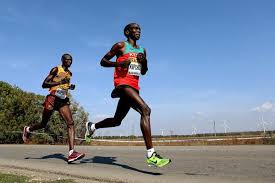Running Posture and Technique to Minimize Injury
On Tuesday June 27 Dave, Alysun Lillico, Physiotherapist and Larissa Robinson (our newest team member, massage therapist) joined forces to present to the Triathlon Club of Burlington on running posture and technique. Our message was simple, there is no perfect way to run, however there are some changes you may want to consider to improve your performance and minimize your risk for injury.
Run tall
When you watch some of the best distance runners in the world, like Eliud Kipchoge, what do you see?

Almost universally they all run with great posture. And here I’m referring to spinal posture. Some coaches will use the cues ‘hips high’, ‘straight spine’ but I prefer the simple cue run tall. This encourages an active, erect posture with the neck aligned over the upper back and sets up the shoulder blades for a relaxed down and back position to help with a good ‘elbow drive’. There are many ways to practice good running posture (standing plank with a forward lean from the ankles, or practice your tall posture during your A’s/B’s and C’s), but simply reminding yourself to run tall throughout your run is sufficient.
Forward Lean
There is lots of controversy in the literature on how much (if any) of lean is best to minimize injury and optimize performance. On the balance there seems to be more coaches that favour a slight lean to encourage efficiency and avoid overworking the anterior thigh (quadriceps) and anterior hips (hip flexors). But where does the lean come from, the ankles or the hips? As it turns out, that may be more of an individual preference.
A forward lean from the ankles will increase stress to the bottom of the foot (including plantar fascia), Achilles and calf, whereas a forward lean from the hips will increase the workload to the posterior hips, hamstrings and the low back. If you want to prove that to yourself, stand up straight with your weight equally over your entire foot. Now keep your body straight, but lean from the ankles shifting your weight towards your forefoot. If you hold that position, at the point just before your body wants to fall forward, you will feel your foot, ankle and calf bear the load. Now standing tall place your hands over the front of your hips and lean (‘hinge’) forward at your hips. Even holding a slight lean done properly should demonstrate some work to your low back, back of the hips (glutes) and back of the thighs (hamstrings).
So if you have an injury or are working through some strain in your Achilles for example, adopting a slightly more dominant hip lean strategy may be helpful. Anterior knee pain is another good example where a forward hip lean strategy can be a game changer.
Even a slight change in your lean (just a couple degrees from upright) over the course of a training session or training cycle can cause a significant shift in tissue load (for the better or worse)…so proceed with caution and get to know what works best for you.
Run Quick
Not velocity. Cadence. Run with quick feet.
Cadence is how quickly your feet turnover after each stride to contact the ground again. Cadence for running is calculated by each time your left AND right foot hits the ground. In cycling your cadence is a full rotation on ONE side. In general a quicker cadence means shorter stride length and less contact time for each foot on the ground. We recommend a cadence in the range of 170-190 which should minimize the tendency for over striding (your foot contacting the ground in front of your hips) and can help manage ground reaction forces.
To optimize push power from your large muscles of the posterior hip (glutes) and posterior thigh (hamstring) foot contact should be ideally directly under the hip or even slightly behind the hip, but not reaching ahead of your hips. Unless you have someone videotaping you running you might not be aware of where your foot contact is happening relative to your foot, but the good news is you don’t have to worry about it if you are ‘running quick’. A quick cadence will generally solve the potentially problematic over striding issue without analyzing your running technique to death. Overstriding can cause hamstring issues, ITB issues, shin splints and the list goes on.
A quicker cadence will generally result in less ground reaction forces. Managing ground reaction forces are of particular importance if you are suffering from joint pain in the ankles, knees, hips or low back or bone pain/stress such as a mounting stress fracture in your foot or shins.
Run quiet
Pretend you are running on thin ice.
Take out those ear buds and listen to the impact of your shoe hitting the ground. The most scientifically supported way to minimize ground reaction forces (see above) is to try and run quieter. Don’t overthink this.
By running quieter you will have naturally adopted a strategy to dampen the ground reaction forces which is a great starting point for almost every running related injury.
